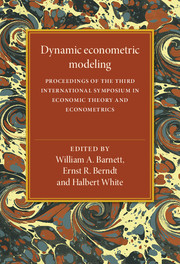 Dynamic Econometric Modeling
Dynamic Econometric Modeling Book contents
- Frontmatter
- Contents
- Editors' introduction
- List of contributors
- Part I Dynamic structural modeling
- Part II Linear time series modeling
- Part III Chaotic attractor modeling
- 11 The aggregation-theoretic monetary aggregates are chaotic and have strange attractors: an econometric application of mathematical chaos
- 12 Theorems on distinguishing deterministic from random systems
- Part IV Applications
12 - Theorems on distinguishing deterministic from random systems
Published online by Cambridge University Press: 03 May 2010
- Frontmatter
- Contents
- Editors' introduction
- List of contributors
- Part I Dynamic structural modeling
- Part II Linear time series modeling
- Part III Chaotic attractor modeling
- 11 The aggregation-theoretic monetary aggregates are chaotic and have strange attractors: an econometric application of mathematical chaos
- 12 Theorems on distinguishing deterministic from random systems
- Part IV Applications
Summary
Introduction
Recently there has been much interest in chaotic dynamical systems and empirical tests on time series for the presence of deterministic chaos. A survey and exposition of some of this activity and especially empirical methodology is contained in Barnett and Chen (this volume) and Brock (1986). Deterministic chaos can look random to the naked eye and to some statistical tests such as spectral analysis.
In Brock and Dechert (1986) it is shown how a simple map from the closed interval [−½,½] to itself can be used to generate a time series of pseudorandom numbers {xt} that are uniformly distributed on [−½,½]. This is well known. Brock and Dechert also show how this time series generates a Hilbert space of pseudorandom variables that is mean–square norm isometrically isomorphic to the Hilbert space of random variables generated by white noise {∈t}, where {∈t} is an independent and identically distributed (i.i.d.) sequence of random variables. Since the Wold decomposition theorem implies that a large class of stationary stochastic processes can be represented as a moving average of white noise (Anderson 1971, pp. 420–1), the Brock and Dechert result shows that examination of the empirical spectrum or, equivalently, the empirical autocovariance function of a time series {at} cannot tell the analyst whether {at} was generated by a deterministic mechanism or a stochastic mechanism. Something else is needed to distinguish deterministic from random systems.
- Type
- Chapter
- Information
- Dynamic Econometric ModelingProceedings of the Third International Symposium in Economic Theory and Econometrics, pp. 247 - 266Publisher: Cambridge University PressPrint publication year: 1988
- 30
- Cited by
